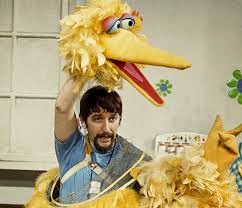It's been literally
decades since I've watched an episode of Sesame Street,
but I can say without equivocation that it was a major formative
influence on my youth. More than one generation of American children
(and quite a few worldwide) learned how to count, how to tell the
letters of the alphabet, and how to appreciate silly foam puppets
from watching Jim Henson's incredible brainchild. It first aired in
the late '60's—I wasn't born until the early '70's, but I started
watching it soon enough that I caught it in what I consider to be its
best incarnation, back when it had that funky, groovy psychedelic
style rooted in colorful animation and soul-inflected music. The
puppet sketches were funny, informative and a little sardonic, a
quality that probably had more than a little to do with the snarky,
ironic sensibilities that came to characterize Generation X twenty or
so years later. And more than one twenty-something I knew in the
early-to-mid '90's had some item of Sesame Street
paraphernalia to commemorate the lamented loss of their childhood
(Scooby Doo and Star Wars were also very
popular).
What I didn't realize
at the time, because I didn't have enough experience of the world to
understand, was that Sesame Street was set in New York
City. It's not a fact important to an enjoyment of the show, but in
retrospect it makes its conception easier to grasp. Henson and
company didn't just want to teach children about the fundamentals of
numbers and letters—they wanted them to learn about the diversity
of races and cultures of the world. What better setting for that
lesson than New York, one of the most diverse cities on the face of
the Earth. A part of me wonders if today's arch-conservatives don't
curse Henson for helping to create so many free-thinking,
multiculture-loving, socialist liberals (“socialist” here meaning
anything that doesn't encourage you to be a paranoid, hateful prick).
All these years I've
never thought very deeply about the origins of the show, or about the
people who performed on it. Which is probably what made my recent
viewing of I Am Big Bird—at the Loft Theater in
Tucson, AZ--so fascinating. The movie focuses on the life and career
of Caroll Spinney, the man who has for over forty years played both
Big Bird and Oscar the Grouch. A gentle and sweet-tempered man,
Spinney has shown a level of dedication to children's entertainment
and puppeteering that is nearly epic, especially in light of the
intense harassment he's suffered over the years for the sake of his
art. He demonstrated an interest in puppets from a very young age, a
fact that, not surprisingly, encouraged his peers to consider him gay
at a time when, you know, having a sexuality that deviated even a
degree from obnoxiously straight could get you seriously beaten or
killed. He also suffered a terrible first marriage to a woman
contemptuous of his work and a lot of bullying from his long-time
director on the show. Many people would have quit. Instead, Spinney
made iconic characters and memorable childhoods.
Much of the runtime
deals with his second marriage to someone who probably fits the
definition of the expression “soul mate” about as well as
anybody. What the filmmakers appear to want to do more than anything
is communicate the degree to which the couple love one another, and
they succeed capably. Be warned—I Am Big Bird is a
shameless, relentless tearjerker. Anyone who can get through Big
Bird singing at Jim Henson's funeral without tearing up isn't a
person I want to know. If that's what you seek in documentaries,
look no further.
What they don't dwell
on quite as much, and I wish they had, are the more technical aspects
of Spinney's job. When they do, it really brings home how much
devotion and stamina the man must possess. He can't actually see out
of the costume; he requires a small TV monitor that he wears around
his waist, with his lines clipped out of the script, pasted onto
cardboard and set on top of it. Everything he does—walking,
jumping, skipping, even crossing a stream on stepping stones, is done
virtually blind and while performing in character. It always pisses
me off when somebody looks at a person who works in the arts and
doesn't think they really work. Try doing what Spinney does, and has
done for forty years, for just one day, and say that isn't skilled
labor.
Middle-aged people like
me who haven't watched Sesame Street in decades can
forget how big of a deal it was back in the day. Prior to Elmo and
Dora the Explorer (they're still a thing with kids now, right?), Big
Bird was the king of children's television. He traveled the world as
a kind of ambassador, sold billions of tons of merchandise, and has
stayed in the memory of every kid who grew up with him. I'm grateful
a documentary like I Am Big Bird got made—it did a
lot to remind me of what I considered important before public school
made a lifelong cynic out of me and my interests turned to giant
monsters and slasher movies.




No comments:
Post a Comment